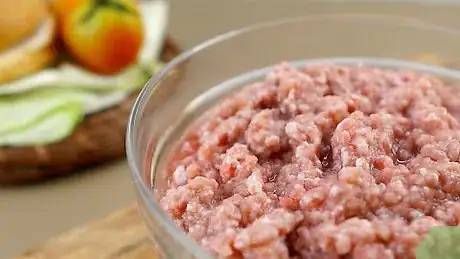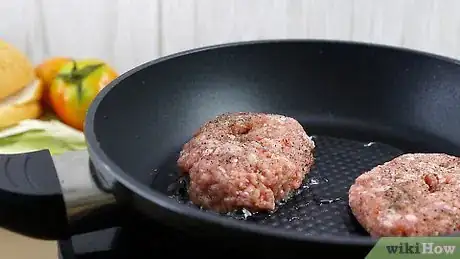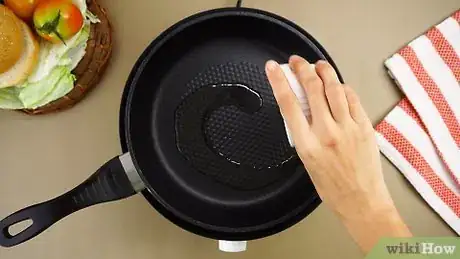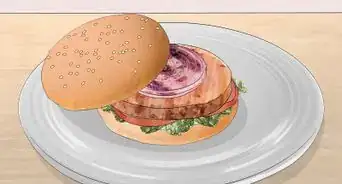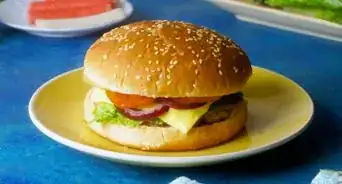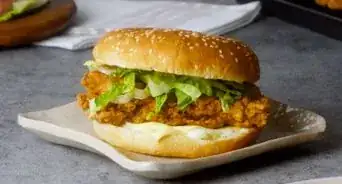This article was co-authored by wikiHow Staff. Our trained team of editors and researchers validate articles for accuracy and comprehensiveness. wikiHow's Content Management Team carefully monitors the work from our editorial staff to ensure that each article is backed by trusted research and meets our high quality standards.
There are 13 references cited in this article, which can be found at the bottom of the page.
The wikiHow Video Team also followed the article's instructions and verified that they work.
This article has been viewed 53,970 times.
Learn more...
Few people can resist the taste of a juicy meat patty in a crisp bun customized with their favorite toppings, but cooking the perfectly-shaped burger is another matter. Burgers have a tendency to swell up like a football as they cook. The edges of a patty cook faster than its center, causing the meat to puff up as it shrinks. You can avoid this problem through a few easy techniques, like pressing down on the raw burger patties with your thumb or by smashing them flat. They will allow you to make delicious, flat burgers on a grill, flat top, or skillet.
Ingredients
- 1 lb (0.45 kg) ground beef
- 1 teaspoon (5.90 g) of salt
- 1 teaspoon (2.33 g) of black pepper
- 1 teaspoon (9.84 g) of garlic powder or other seasonings
- Lettuce, tomatoes, and other toppings
- 4 to 6 burger buns
Makes 4 to 6 servings
Steps
Using the Right Meat
-
1Buy ground beef that is 80% meat and 20% fat. The fat is what holds the meat together, so leaner meat will usually give you a hard time. If you want your burgers to be shapely, ground chuck works very well, but you could also use ground sirloin for more flavor. You could also mix lean meat with some sort of fat, such as by combining equal amounts of ground beef and pork.[1]
- Leaner meats like turkey are mixed with high-fat ingredients like eggs, milk, or even yogurt to help them maintain their shape. Veggie burgers can be made the same way.
-
2Get course-ground meat if it is available. Most ground beef sold in supermarkets is medium-ground. This kind of meat works well enough, but it isn’t the best available. If you really want to ensure the burgers hold their shape, ask your butcher for help. Visit a local butcher shop or ask someone at the supermarket meat counter for course-ground meat.[2]
- Medium-ground meat generally gets processed up to 5 times, so it doesn’t hold together as well as coarse-ground meat. Coarse-ground meat is only processed once before it is packaged for sale.
- You could also make your own burgers at home if you have a meat grinder.
Advertisement -
3Roll the meat into balls that are all the same size. Divide up the meat according to the number of burgers you plan on making. After separating the meat, roll each piece between your hands. Make sure the meat sticks together, but handle it gently to avoid overworking it. Once you have some consistent meat balls to cook, set them aside until you’re ready to throw them onto your pan.[3]
- For example, 1 lb (0.45 kg) of meat generally makes 4 burgers. The burgers will be 1⁄4 lb (0.11 kg), so get more meat if you plan on making bigger burgers.
- If you buy prepared ground beef from your local grocery store, it will probably come in a big pack. Instead of dividing up the meat, try using a 4 oz (110 g) ice cream scooper to form balls that don’t require any additional rolling.
- Don’t season the meat just yet. While you can attempt to mix in all sorts of seasoning now, you run the risk of working the meat so much that it doesn’t retain its shape later.
Cooking Flat Burgers on a Grill
-
1Preheat vegetable oil on a grill or skillet over medium-high. Rub about 1 tablespoon (15 mL) of the oil onto the grill grate or flat top before turning it on. Then, set it to 450 °F (232 °C). Let it heat up for about 15 minutes while you prepare the burger patties.[4]
- If you’re cooking on a stovetop, the oil will heat up within about 2 minutes.
- To cook with an oven broiler, line a sheet pan with foil or oil it so the burgers won’t stick.
-
2Spread the meat into a patty 3⁄4 in (1.9 cm) thick. Press the meat flat by hand or with a spatula. Make sure the entire patty is a consistent thickness. It should be flat on the top and bottom. Any parts that are uneven will cook at a different rate, which can affect the burger’s shape.[5]
- Make each burger patty as uniform as possible. If the center is bigger than edges, it will swell up before it finishes cooking.
-
3Use your thumb to make a 1 1⁄2 in (3.8 cm)-wide dimple in the center. Place your thumb on the patty and press down gently. Make it so the patty is about 1⁄2 in (1.3 cm) thick in the center. Its edges will still be about 3⁄4 in (1.9 cm) thick.[6]
- That small indentation is enough to help the burger hold its shape. With it, the center part will only puff up a little bit as the thicker edges cook.
-
4Sprinkle the patties with salt, pepper, and other seasonings. Try using about 1 teaspoon (5.90 g) of salt and 1 teaspoon (2.33 g) of black pepper to season 4 to 6 patties. Season each liberally. Salt and pepper is enough to make delicious, flat burgers, but you can use all sorts of other seasonings, including onion powder, garlic powder, paprika, or even brown sugar.[7]
- Coat the patties with a seasoning mix right before or right after putting them on a hot grill or pan.
- For instance, try combining 1 tablespoon (9.84 g) of garlic powder with the salt and pepper. You could then add an equal amount paprika to make the meat more savory or brown sugar to give the meat a sweeter, more balanced flavor.
- You can also add ingredients like 1 teaspoon (4.9 mL) of Worcestershire, soy, or fish sauce. The extra moisture keeps the meat juicy while also helping it stick together.
-
5Cook the burger for 4 to 5 minutes per side. Transfer the patty to the grill or oven to start that delicious smell of meat browning. Leave it alone while it cooks. After the time is up, flip it over with your spatula so it can continue cooking on its other side. As long as both sides cook evenly, you should end up with a puck-shaped patty that won’t make your burger look like a leaning tower.[8]
- If you’re a fan of cheeseburgers, place a slice of cheese on the patty after flipping it. The cheese will melt while the bottom half of the patty finishes cooking.
- The burger will look completely brown, almost burned black, once it has finished cooking. Make sure the burger looks cooked before flipping it or taking it off of the heat. Give it extra time if you think it’s still a little underdone.
- You can use a meat thermometer to test the burger’s center for doneness. Cook it to 160 °F (71 °C) to ensure it’s safe to eat.
Making Smashed Burgers on a Flat Top
-
1Warm vegetable oil over medium-high heat in a skillet or flat top. Pour about 1 tablespoon (15 mL) of the oil into the pan. Let it warm up for about 2 minutes. Before attempting to cook your burgers, tilt the pan back and forth to spread the oil out across it. Make sure the pan is covered all over with a thin coating of the oil.[9]
- You won’t need a ton of oil for your burgers. The fat in the meat keeps the patties moist and held together. However, that little bit of oil is good for preventing the meat from sticking to the pan.
- Vegetable oil is the best choice because it doesn’t burn easily. Butter and other types of cooking oil can also be used, but make sure they don’t start to smoke.
-
2Place the meat in your pan and smash it flat. That’s right, you will have to squash those meat chunks you just spent time rolling up—but don’t worry, it’s a good thing. Press it down very firmly with a spatula. Make each patty as flat as you can. As long as it looks flat, it will cook evenly without ballooning up in the center.[10]
- This won’t work as well on a grill grate since the meat will get pushed straight through its openings. Broiling can work, but smashed burgers are meant to be made in a pan.
- The patties may look a little rough around the edges, but that is okay. The edges can be a little taller than the center. If the center is taller, your burger won’t stay flat.
- You may have heard that pressing burger patties flat causes them to dry out. Since the meat is still raw, it won’t lose any juice when you flatten it.
- Fit as many of the meat balls in the pan as you can. Remember to leave enough room for the meat to spread out when you flatten it with your spatula. Depending on the size of your pan, you may need to work in batches.
-
3Season the burgers with salt and pepper if you wish. The best time to season the burgers is while they are flat but still raw. Add as much of each ingredient as you would like. Try using about 1 teaspoon (5.90 g) of salt and 1 teaspoon (2.33 g) of black pepper for each patty. You can spice up the patties with additional seasonings or skip seasoning entirely if you prefer your burgers plain.[11]
- For example, try adding 1 teaspoon (3.28 g) of garlic powder to each patty.
- If you’re using a seasoning mix, sprinkle it evenly across all the burgers you’re making. Save half of it for when you flip the burgers, too!
-
4Cook the burger for about 2 minutes until the bottom is brown. Leave the patties undisturbed while they cook. Set a timer so you can flip them before they overcook. When time is up, scoop up the patties with your spatula. The cooked side should look completely brown and even a little crispy in some places.[12]
- Watch for the outer edges of the patties to turn brown. If the edges look brown, the thin center will also have cooked through.
- If the burger doesn’t look done on the bottom, let it cook a little longer. However, 2 minutes is more than enough for smash burgers since they are so thin.
-
5Flip the patties over and season them with salt and pepper. Turn them over one by one, keeping them separate in the pan. Spread a liberal amount of salt and pepper across the patties. Try using about 1 teaspoon (5.90 g) of salt and 1 teaspoon (2.33 g) of black pepper for each one again. You can then top each one with a slice of cheese if you’re making cheeseburgers.
- You can add other seasonings, like garlic, or leave out the pepper if you wish.[13]
- Adding seasoning twice is a little extra work, but it’s better for shaping your burgers. You don’t have to try mixing the seasonings into the meat, so there is no risk of overworking the meat. It won’t lose its shape in the pan!
-
6Cook the patties for another minute until they are brown all over. Resist the temptation to touch or otherwise move the burgers while they’re cooking. Watch for them to begin browning around the edges. Since they are already half-cooked, they won’t need as long to finish. Once time is up, pick up the burgers with a spatula and check them to see if they are brown all over before serving them.[14]
- If you’re making cheeseburgers, add cheese when you flip the burgers and watch for the sides of the cheese to begin drooping.
- Use a meat thermometer to make sure the burgers are done. They will be about 160 °F (71 °C) in the center.
Warnings
- To limit the spread of bacteria always wash your hands before and after handling burger meat.⧼thumbs_response⧽
- Undercooked meat increases your chance of catching a food-borne illness. For safety, cook burgers to 160 °F (71 °C).[17]⧼thumbs_response⧽
Things You’ll Need
Using the Right Meat
- Mixing bowl
- Measuring cup and spoons
Cooking Flat Burgers on a Grill
- Stove, oven, or grill
- Spatula
- Measuring cup and spoons
Making Smashed Burgers on a Flat Top
- Stove
- Skillet or griddle
- Spatula
- Measuring cup and spoons
References
- ↑ https://www.dmagazine.com/publications/d-magazine/2015/september/how-to-make-the-perfect-burger/
- ↑ https://www.theguardian.com/food/2019/jun/14/homemade-burgers-patty-perfect-shape-secret-flat-bulge-shrink-kitchen-aide
- ↑ https://www.theguardian.com/food/2019/jun/14/homemade-burgers-patty-perfect-shape-secret-flat-bulge-shrink-kitchen-aide
- ↑ https://parade.com/896651/parade/learn-how-to-style-a-mouth-watering-cheeseburger-in-our-latest-episode-of-plate-it-perfect/print/
- ↑ https://cfaes.osu.edu/features/5-tips-for-grilling-the-perfect-burger
- ↑ https://www.lovefood.com/news/56462/ultimate-burger-cooking-tips-hacks-tricks-perfect-buns
- ↑ https://www.lovefood.com/news/56462/ultimate-burger-cooking-tips-hacks-tricks-perfect-buns
- ↑ https://cfaes.osu.edu/features/5-tips-for-grilling-the-perfect-burger
- ↑ https://www.thrillist.com/recipe/nation/how-to-make-the-perfect-diner-burger-at-home-thrillist-recipes
- ↑ https://www.burgerartist.com/recipe/smashed-diner-burger/
- ↑ https://www.bonappetit.com/recipe/the-ba-smash-burger
- ↑ https://foodchannel.com/recipes/the-classic-smash-burger
- ↑ https://www.epicurious.com/recipes/food/views/the-ba-smash-burger-56390134
- ↑ https://www.epicurious.com/recipes/food/views/the-ba-smash-burger-56390134
- ↑ https://aht.seriouseats.com/2010/03/the-burger-labs-top-ten-tips-for-better-burgers.html
- ↑ https://genuineideas.com/ArticlesIndex/saltyburger.html
- ↑ https://www.fsis.usda.gov/wps/portal/fsis/topics/food-safety-education/get-answers/food-safety-fact-sheets/meat-preparation/ground-beef-and-food-safety/ct_index

